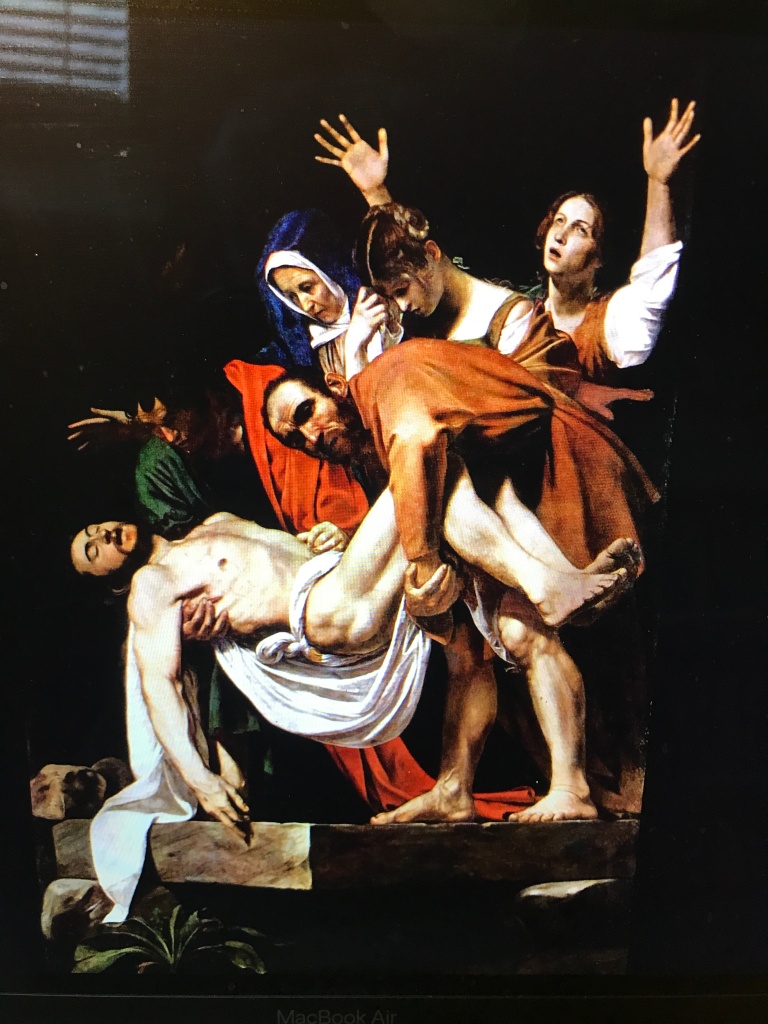March 26, 2024

Late in the afternoon, since it was the Day of Preparation (that is, Sabbath eve,) Joseph of Arimathea, a highly respected member of the Jewish Council, came. He was one who lived expectantly, on the lookout for the kingdom of God. Working up his courage, he went to Pilate and asked for Jesus’ body. Pilate questioned whether he could be dead that soon and called for the captain to verify that he was really dead. Assured by the captain, he gave Joseph the corpse.
Having already purchased a linen shroud, Joseph took him down, wrapped him in the shroud, placed him in a tomb that had been cut into the rock, and rolled a large stone across the opening. Mary Magdalene and Mary, mother of Joses, watched the burial.
Mark 15: 42-47 (paraphrased by Eugene Peterson in The Message: The Bible in Contemporary Language)
Many years ago the Cleveland Museum of Art hosted a traveling show of treasures from the Vatican. Entombment, a large painting by Caravaggio, was one of those treasures. We were living in Cleveland at the time and were among the crowds of people who attended this exhibit. Our son Geof, who is a graduate of the Milwaukee Institute of Art and Design, became our unofficial guide as we moved through the galleries. In his quiet voice, he pointed out aspects of the paintings I would surely have missed otherwise. Many people listened to an audio tour prepared by the museum, but even so I noticed a number of people paying attention to what Geof was saying and watching where he was pointing.
How true that was when we entered a room where the only painting was Entombment.
After spending time gazing at the painting, trying to take in the lifeless body of Jesus, the grief of those in attendance, and the strength and struggle of the men as they placed the body in the tomb, Geof suggested we move to the left side of the painting and kneel–not as an act of adoration and devotion, although I remember feeling that, but in order to experience the painting from a different perspective.
Joseph of Arimathea seemed to be looking right at me, asking for my help. I was in that tomb, too, positioned to receive and to ease the body onto that hard slab of rock. When we eventually left that room, that tomb, I noticed others taking the same posture as Geof had shown me.
The Passion Story
During our Sunday morning worship service, Palm Sunday, the Passion Story according to the Gospel of Mark was read. How many times have I read the story in the quiet of my own space, heard the story, seen the story performed, even read aloud for others the story? I know this story, and yet, I am always stunned by the story. Sometimes I imagine myself as Peter, denying three times his relationship with Jesus. Or might I have been one of the Chief Priest’s servant girls who questioned Peter, “You were with the Nazarene, Jesus.” Sometimes I am the woman pouring the expensive perfume over Jesus’ head. Sometimes I am one of the disciples in the room preparing the Passover meal. Sometimes I wonder what it would have been like to carry the cross as Simon of Cyrene, did.
This story has room for each part of me. Each aspect of ourselves.
This time as Joseph of Arimathea’s actions were described, I remembered that Caravaggio painting and how my son had invited me to be in that scene, that moment.
I wondered about my openness, my willingness to receive.
When have I held someone else’s loss? How have I held my own losses?
How have I prepared the tomb for my own death?
Christine Valters Paintner in her new book, A Different Kind of Fast, Feeding Our True Hungers in Lent, invites us to enter the scene. “Help carry the weight of his body.” I see Joseph and his companion strain to hold that deadweight. How am I asked to lighten that load? To share that burden?
I don’t recall thinking much about the others depicted in the painting, but Paintner suggests:
Stand by the tomb as the mourners lay Jesus’s body to rest. Rest in the silence with them for a while. When the time feels right, consider engaging in conversation with one or more people there. Ask them what they have seen, how they feel, what they are going to do now. Have a dialogue with the garden, the plantlife, the tomb itself, Jesus’s body.
Sit inside the tomb for a period of time. Rest into the waiting. Recognize those places in your own life where you await new life.
p. 214.
This is what these Holy Week days are about–to see and to know ourselves in the story. To discover a new perspective and to lean into the new life awaiting us.
May these coming days deepen your awareness of the movement of God in your life.
An Invitation
When have you heard or experienced something familiar in a new way and gained a new perspective? I would love to know.
Well done. We all reflecting
LikeLiked by 1 person
thank you Nancy. God bless
LikeLiked by 1 person
And thank you and may you be richly blessed.
LikeLike
I have always felt very alone with any loss during my lifetime. I am not a good one to carry another’s loss as I only know my own solitude.
LikeLiked by 1 person
I wonder if you can imagine–just imagine, using all the skills you have when you read books to the children in the classrooms you visit and when you invite them to respond–how it might feel to allow someone to be with you in your loss. Just imagine.
LikeLike
Very rich reflection. Worth pondering now and in to the Eastertide.
LikeLiked by 1 person
Thanks. The Triduum is almost upon us.
LikeLike